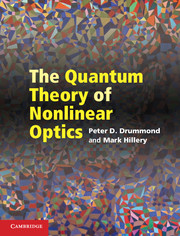Book contents
- Frontmatter
- Contents
- Preface
- Introduction
- 1 Classical nonlinear optics
- 2 Field quantization
- 3 Quantized fields in dielectric media
- 4 Microscopic description of media
- 5 Coherence and quantum dynamics in simple systems
- 6 Decoherence and reservoirs
- 7 Phase-space distributions
- 8 Single-mode devices
- 9 Degenerate parametric oscillator
- 10 Quantum field dynamics
- 11 Quantum propagation in fibers and waveguides
- 12 Quantum information
- List of symbols
- Index
- References
5 - Coherence and quantum dynamics in simple systems
Published online by Cambridge University Press: 05 May 2014
- Frontmatter
- Contents
- Preface
- Introduction
- 1 Classical nonlinear optics
- 2 Field quantization
- 3 Quantized fields in dielectric media
- 4 Microscopic description of media
- 5 Coherence and quantum dynamics in simple systems
- 6 Decoherence and reservoirs
- 7 Phase-space distributions
- 8 Single-mode devices
- 9 Degenerate parametric oscillator
- 10 Quantum field dynamics
- 11 Quantum propagation in fibers and waveguides
- 12 Quantum information
- List of symbols
- Index
- References
Summary
In this chapter we will consider some simple systems arising out of the Hamiltonians in the previous chapters. Here, we will look at these systems without considering damping or reservoirs. These systems involve only a small number of field modes – typically one, two or three. We will revisit them in later chapters to consider what happens when the fields are confined to a cavity with damping, including possible input and output coupling.
Before discussing the models, however, we need to describe a number of features of fields consisting of a small number of modes. We will begin with a discussion of the quantum theory of photo-detection and optical coherence, due to Mandel and Glauber. This makes use of the microscopic model for atom–field interactions in the previous chapter, to allow us to introduce a theory of coherence and photon counting.
We will also treat the representation for a single-mode field known as a P-representation. This will be the first quasi-distribution function we will encounter. It is a c-number representation of the quantum state of a field mode. As we shall see in subsequent chapters, quasi-distribution functions are very useful in describing the dynamics of interacting quantum systems coupled to reservoirs. We will then go on to use the P-representation to define the notion of a nonclassical state of the field; such states are signified by the fact that the P-representation is no longer a well-behaved, positive distribution. Nonclassical states are natural results of nonlinear optical interactions, and we will show how that comes about for some of our models. It is also possible to define P-representations for multi-mode fields. This leads to a discussion of nonclassical correlations between modes.
- Type
- Chapter
- Information
- The Quantum Theory of Nonlinear Optics , pp. 144 - 183Publisher: Cambridge University PressPrint publication year: 2014



